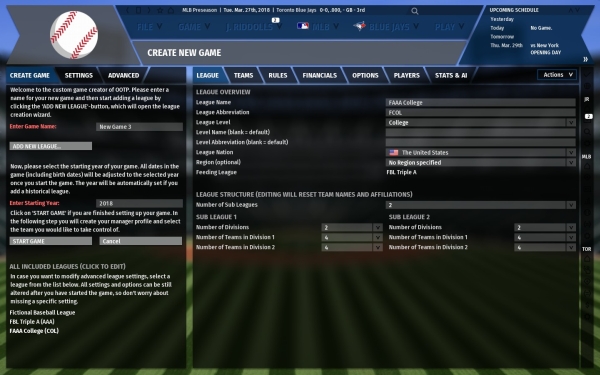| Find in this manual | ||
| Replace with | ||
As you add minor leagues to your setup via the Create New Game screen, you may notice the option to add a "College Feeder League" or a "High School Feeder League":

A feeder league feeds players into its parent league. Feeder leagues have minimum and maximum age limits for players, and once players exceed their age maximum, the players go into the draft pool for their parent league. When a new season starts in a feeder league, the rosters are filled up again with players of the minimum age. As older players get drafted (or become free agents if undrafted), younger players get added automatically for the following season. Each feeder league can feed players into only one league, and you cannot have a 'daisy chain' of feeder leagues. That is, you can't have a high school league that feeds into a college league that feeds into a professional league.
There are two types of feeder leagues: college and high school. These two types behave identically. The names, like league levels, are mainly just for categorization.
Important: Feeder leagues are not meant to simulate real-world college and high school baseball. There is no early entry into the draft, recruiting, redshirting, or similar staples of college and high school baseball.
Feeder leagues add immersion, providing a draft pool full of players with several years of statistical history leading up to the draft, in addition to scouting reports. This gives general managers much more information on which to base draft decisions. This is particularly helpful in leagues that allow the trading of draft picks, because GMs can make intelligent decisions about how strong a particular draft class looks by scouting and researching the draft class in advance.
Feeder leagues behave very similarly to minor leagues. Players in feeder leagues have minor league contracts and share all the rules of the parent league.
Players in a feeder league will appear in the first-year player draft pool of the major league once they are no longer eligible for their feeder league. Your first-year player draft will also be supplemented with enough fictional players to fill out the draft, if necessary. High school players who are not drafted may continue on to college, or may become free agents. College players who are not drafted may become free agents.
How Many Feeder Leagues Should I Create?
The number of feeder leagues you create is completely up to you. However, most people who use feeder leagues prefer to set them up in such a way such that your parent league's first-year player draft will be completely populated with feeder league players. Because there are so many ways to configure your game, there isn't an easy formula for precisely how many feeder leagues you must create to accomplish this. However, here are some guidelines on how to decide about feeder leagues:
First, decide how many draft rounds you will need in your first-year player draft. The rule of thumb is that you will need five new players for each level of minors to replace players who retire, have long-term injuries, etc. Therefore:
# of rounds in amateur draft = 5 * the # of levels of minor leagues in your game
For example, you have a parent league with AAA, AA, A, and rookie leagues. That's four levels of minors. 4 x 5 = 20 You should configure your parent league to have 20 rounds in the amateur draft.
Next, decide on the number of feeder teams you will need to populate this draft. Each feeder team produces 6 to 9 players for the draft per year. Taking the number of players needed for the draft and dividing by 6 gives you the minimum number of feeders you need. The guideline here is:
# of feeder teams needed = (number of teams in parent league x number of draft rounds)/6
So, using the example from above, let's say your parent league has 16 teams. (16 x 20)/6 = 53.3 I need around 53 feeder league teams to completely feed my draft with feeder league players. The configuration of teams in your feeder leagues does not matter, as long as you have 53 teams or so. Many people increase this number, resulting in more players than there are draft slots. Players that go undrafted will become free agents. If you create a configuration that doesn't generate enough feeder league players, OOTP will generate fictional players for the draft pool to cover the difference.
Increasing Feeder League Realism
While feeder leagues are intended primarily just as a source of players to be drafted, some people want the feeder leagues to behave as close to real life as possible. Some members of the OOTP community have recommended the following settings for feeder leagues:
For High School feeder leagues:
- On the Rules screen, set the Age Minimum to 14.
- On the Rules screen, set the Age Maximum to 17.
- On the Options screen, set the Create Age Min. to 14.
- On the Options screen, set the Create Age Max. to 14.
This will result in most high school players playing for four years and entering the draft at age 18.
For College feeder leagues:
- On the Rules screen, set the Age Minimum to 18.
- On the Rules screen, set the Age Maximum to 21.
- On the Options screen, set the Create Age Min. to 18.
- On the Options screen, set the Create Age Max. to 18.
This will result in most college players playing for four years and entering the draft at age 22.